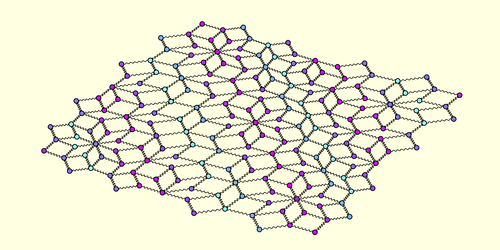Golden Ratio in Quasicrystal Vibrations
Quasicrystals, with their nonrepeating atomic lattices, offer the potential for future materials with tailored heat- and charge-conduction properties, which are influenced by the lattice structure and its vibrations, also called phonons. However, previous studies of quasicrystal phonons have not revealed the expected influence of their unusual lattice. Now Masato Matsuura of the CROSS Neutron Science and Technology Center in Japan and his colleagues have uncovered a unique phonon behavior in quasicrystals: The number of phonons propagating in the lattice is notably smaller at specific phonon energies that are related to each other through the golden ratio, a mathematical constant that is also linked to the geometry of quasicrystals’ nonperiodic lattice [1]. This observation confirms decades-old theoretical predictions distinguishing quasicrystal phonons from those in crystalline materials.
The team directed a neutron beam at a centimeter-sized sample of the quasicrystalline material Al73Pd19Mn8. Following standard techniques, the researchers analyzed the energy and direction change of the scattered neutrons to determine the energy, direction of motion, and number of phonons generated by the neutron–sample interactions.
In a spectrum of phonon number versus phonon energy, the team observed sharp dips at energies approximated by multiplying each successive energy by the golden ratio, which is about 1.6: 0.12, 0.19, 0.31, 0.51, 0.82, 1.33, and 2.15 meV. The analysis also revealed that the phonons propagate in preferred directions. In addition, the number of phonons generated when neutrons gain energy from the lattice during scattering is different from the number generated when they lose energy. Such an asymmetric scattering process has never been seen in phonons in conventional crystalline materials. Because of these phonon properties, quasicrystals could find applications in thermal management devices, the researchers say.
–Martin Rodriguez-Vega
Martin Rodriguez-Vega is an Associate Editor for Physical Review Letters.
References
- M. Matsuura et al., “Singular continuous and nonreciprocal phonons in quasicrystal AlPdMn,” Phys. Rev. Lett. 133, 136101 (2024).





